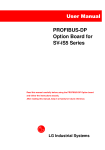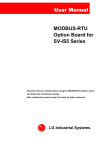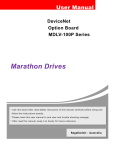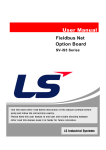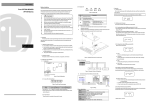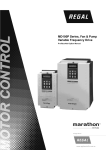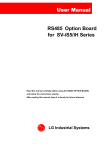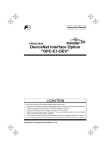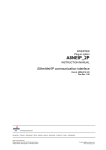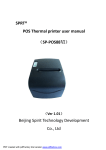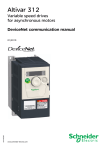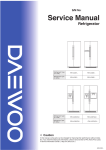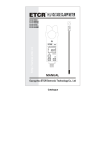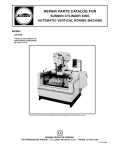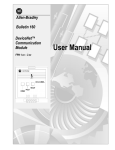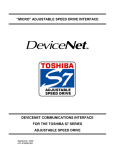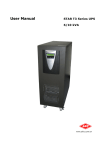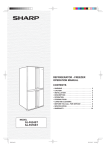Download DeviceNet Option Board
Transcript
User Manual DeviceNet Option Board for SV-iS5 Series Read this manual carefully before using the DeviceNet Option Board and follow the instructions exactly. After reading this manual, keep it at handy for future reference. LG Industrial Systems Thank you for purchase of LG DeviceNet Option Board! SAFETY PRECAUTIONS Always follow safety precautions to prevent accidents and potential hazards from occurring. Safety precautions are classified into “WARNING” and “CAUTION” in this manual. WARNING CAUTION Indicates a potentially hazardous situation which, if not avoided, can result in serious injury Indicates a potentially hazardous situation which, if not avoided, can result in minor to moderate injury, or serious damage to the product. Throughout this manual we use the following two illustrations to make you aware of safety considerations: Identifies potential hazards under certain conditions. Read the message and follow the instructions carefully. Identifies shock hazards under certain conditions. Particular attention should be directed because dangerous voltage may be present. Keep this manual at handy for quick reference. CAUTION Be sure to take ESD (Electrostatic Discharge) protection measures when you touch the board. Otherwise, the option board may get damaged due to static charges. Implement wiring change on the Option Board after checking that the power supply is off. 1 Otherwise, there is a danger of connecting error and damage to the board. Be sure to fix inverter to option board tightly. Otherwise, there is a danger of connecting error and damage to the board. Be sure to install a termination resistor (120ohm, 1/4W) at the end of the network. Be sure to check parameter unit when setting parameters. Otherwise, there is a danger of connecting error. 2 CHAPTER 1 - INTRODUCTION By using a DeviceNet communication board, SV-iS5 inverter can be connected to a DeviceNet network. 1.1. Through LG DeviceNet Option Board… Inverter can be controlled and monitored by PLC sequence program or any Master Module. Multiple inverters can be connected to one communication cable with simple and easy installation, dramatically saving wiring, maintenance cost and time. Compatible with PC System, PLC and any controllers is available, making Factory Automation more easily. 1.1.1. Vocabulary In this manual we refer to the: DeviceNet Option Board for iS5 series as the Option Board iS5 series inverter as the inverter 1.2. Kit Contents The DeviceNet option board kit consists of: DeviceNet Option Board, 1 pcs 5 pin Connector, 1 pcs Mounting poles, 3 pcs Installation Manual 1.3. DeviceNet Option Board Specification Device Type: AC Drives Explicit Peer to Peer Messaging: Support I/O Peer to Peer Messaging: N/A (Not Available) Configuration Consistency Value: N/A Faulted Node Recovery (Off-Line): Support 3 Baud Rate Support: 125, 250, 500 (kbps) Master/Scanner (Predefined M/S Connection): Support I/O Slave Messaging - Polling: Support - Bit Strobe, Cyclic, COS (Change of State): N/A Range of Input Voltages: 11 – 25V DC 1.4. Installing the Communication Card 1.4.1. Board Layout Status LED DeviceNet Connector Figure 1 – Board layout 1.4.2. Status LED MS (Module Status) LED Checks the status of incoming power to option board, CPU function and communication to the Inverter. NS Checks the connection of option card on the (Network Status) LED Network and DeviceNet power status. Note) Refer to Chapter 4 - TROUBLESHOOTING for more details. 4 Inverter Connector MS NS 1.4.3. DeviceNet Connection Terminal DeviceNet Terminal Signal Function Cable Color 1 Common Common Black 2 CAN Low Signal Low Blue 3 Shield Shield Bare 4 CAN High Signal High White 5 V+ Power supply Red Terminal Block 1 2 3 4 5 ( 11-24VDC) Figure 2 – DeviceNet Terminal Block 5 CHAPTER 2 - INSTALLING THE OPTION BOARD 2.1. Installing the Option Board to the Inverter Note) DeviceNet Option Board can be installed to the inverter having software V 1.05 and later. Figure 3 – Installing the DeviceNet Board to the Inverter 2.1.1. Setting the DeviceNet Parameter 2.1.1.1. Setting the MAC ID <COM Group, #10> 1. MAC ID (Media Access Control Identifier, Station Number) is a unique value to identify nodes in the DeviceNet Network. When setting, you must ensure that the each serial device on the network has a unique address. 2. Setting and changing MAC ID is available via keypad. 3. The factory default setting is DeviceNet address 63. If DPRAM communication between Inverter and the Option card becomes faulty, the value will default to Station Number 63. 6 Min Value Max Value Parameter Setting 0 63 COM Group, #10 MAC ID 4. When MAC ID is changed during Run, Option board is automatically reset to find the device new MAC ID is allocated on the network. If a duplicate Mac ID is checked, NS (Network Status) LED turns Solid Red. In this case, it should be changed to different MAC ID. In the normal operation, LED color is flashing Green. 2.1.1.2. Setting the Baud Rate < COM Group, #11> Baud Rate Trunk Cable Length Thick Cable Drop Length Thin Cable Max Length Total 125 500 m 156 m kbps (1640 ft.) (512 ft.) 250 250 m 100 m kbps (820 ft.) (328 ft.) 500 100 m 39m kbps (328 ft.) (128ft.) 6 m (20 ft.) 78 m (256 ft.) Table 1 – Baud Rate vs. Cable Length 1. The Baud Rate determines the maximum length of the DeviceNet cable. Refer to Table 1 to determine cable lengths and baud rates. The above is only met when DeviceNet-dedicated cables are used. For more information on the DeviceNet cables, makers and detail specifications, refer to the Open DeviceNet Vendor Association (ODVA) homepage at “http://www.odva.org/”. 2. NS LED remains OFF when the setting of actual Network communication speed and Baud Rate does not match. 3. Set the desirable Baud Rate via Keypad. Changing this parameter does not change the actual data rate until power is cycled. Reset the inverter or request Reset 7 Service to the Inverter Reset Identity Object. 4. NS LED will turn to flashing Green when Network Baud Rate matches Baud Rate of the option card and a unique MAC ID is allocated. 2.1.1.3. Setting Assembly Instance Assembly Instance has four types of Sending/Receiving data through Poll I/O communication. Refer to Assembly Object in Chapter 7 for detailed information. 2.2. Setting Other Parameters 2.2.1. Setting Option Mode [COM Group, #02] Via DeviceNet COM Group, #02 setting Issuing Operating command only Command Issuing Frequency command only Freq Issuing Operating + Frequency command Cmd+Freq Table 2 – Setting Option Mode Note) This setting supercedes setting in FU1 group. 2.2.2. Setting TimeOut [I/O, #49] The factory default setting for TimeOut is 1 sec. When communication between inverter and DeviceNet network is disrupted in the Run mode, inverter checks the communication failure and performs operation under the setting in I/O group #48 until Master-setting Time + preset TimeOut elapses. 2.3. Poll I/O Connection It is a Data transaction between Inverter and Scanner. Input/output size: 4 bytes Communication Rate: 0 (default) Data Transaction: Poll I/O 8 Data transaction thru Poll I/O is determined by the setting of Assembly Instance [COM, #12,13]. Assembly Instance consists of Input and Output, based on Scanner side. Therefore, Input Data means data Scanner receives. For inverter side, it is the feedback value to Scanner. By contrast, Output Data is the data Scanner transmits to the Inverter as a new command. Output Assembly Scanner Inverter (Ex:PLC) Input Assembly Figure 4 - Data Transaction via Poll I/O Communication Scanner Side Inverter Side Input Assembly Data Receive data Transmit data Output Assembly Data Transmit data Receive data 9 CHAPTER 3 - MODES OF OPERATION 3.1. PowerUp Reset mode During a powerup or reset, the option board: 1. Performs powerup initialization. First Module Status LED flashes Green for 0.25sec to Red for 0.25sec and then turns to Solid Green when DPRAM is in normal operation. 2. Then, Network Status LED flashes Green for 0.25sec to Red for 0.25sec 3. After no duplicate MAC ID is detected, Network Status LED flashes Green, indicating the option board is successfully connected to the Network. However, communication with other nodes has not been initiated. If the above steps is failed, follow the below steps. No action is required in the normal operating state. 1. When DPRAM is not working properly, Module Status LED turns Solid Red. In this case, Check the option board’s connection with Inverter first and cycle the power. 2. When NS remains OFF, not flashing Green, 1) Check the DeviceNet Power 2) Check the Baud Rate of Network and the Option board matches. When duplicate MAC ID error occurs, Network Status LED turns Solid Red. In this case, allocate the different MAC ID via Keypad. When the option board is in communication with other nodes, NS (Network Status) LED turns Solid Green. . 3.2. When EMC (Explicit Message Connection) is established by Scanner Network Status LED turns green. During this state, if EMC setting is deactivated, the LED will turn green after 10 seconds delay. Once EMC is connected, I/O Connection setting is available. At this time, the Network Status LED will not change. If I/O Connection is not established within given time, then Time Out will occur 10 and Network Status LED turns flashing Red. (Depending on the time setting of EMC, the status can be changed to green again.) 11 CHAPTER 4 - TROUBLESHOOTING The current status of Device and Network can be monitored through built-in LED (MS, NS). [NS (Network Status) LED] LED Status Cause Diagnostics OFF Off-Line The option card is not Check DeviceNet power and (No Power) receiving power from the cable connections and the power Network. connection on the DeviceNet terminal block. Single node on the Check DeviceNet Master node network operation for correct Communication. Incorrect Baud Rate is Change the baud rate setting and set. reset the inverter. Flashing On-Line, Communication is set Normal operating status before Green Not Connected after duplicate node user makes connection. check is finished, but connection to other node is not completed. Solid On-Line, More than one EMC Polled I/O connection is Green Connected connection is available. (Link OK) established. Flashing Connection Time- Polled I/O connection is Inverter Reset. Red Out Timed Out Request Reset Service to the Solid Red Critical Link Inverter Reset Identity Object. Failure. Retry I/O connection. Faults occurred Duplicate MAC ID check Change the setting of MAC ID. failed Bus Off State Green Flashing Self- diagnostic Device is Check for line connection under diagnostic mode. Red 12 self- Wait for a moment. Red Flashing Communication State of Communication Fault Fault due to the failure Green No action required. to pass the Network Access. Identity communication Fault Request is accepted [MS (Module Status) LED] LED Off Solid Green Solid Red Status No Power 5V Power is not applied to the option card. Diagnostics Check the incoming power to inverter is provided. Check 5V power is ON. Operational Normal operation state Unrecoverable Data transaction through Check the connection between Fault DPRAM is disrupted.. option card and Inverter. Flashing Green & Cause Self Test Red Device is in self-test mode. 1. EDS(Electronic Data Sheet) EDS files are specially formatted ASCII files that provide all of the information necessary for a configuration tool such as the DeviceNet Manager, to access and alter the parameters of a device. The EDS file contains information on the number of parameters in a device and how those parameters are grouped together. Information about each parameter is contained in this file such as parameter min, max, and default values, parameter data format and scaling and the parameter name and units. Install EDS files for iS5 to control iS5 parameters using DeviceNet Manager program. This file can be downloaded from : http://www.lgis.com or contact your LG representative. 13 CHAPTER 5 - DEVICENET DATA TABLES Message R: Read Only R/W: Read / Write enable <Device Profile> AC/DC Drives: 0x 02 <Object Model> Object Class Name Class Code Identity Object 0x01 Message Router 0x02 DeviceNet 0x03 Assembly 0x04 Connection 0x05 Motor Data 0x28 Control Supervisor 0x29 AC/DC Drive 0x2A Inverter 0x64 < Class 1 - Identity Object> Class Code 0x01 Instance 1 (All attributes are instance 1) Attribute ID Attribute Name Access Method 1 Vendor ID R 2 Device Type R 3 Product Code R Revision R 4 Major Revision (High Byte) Minor Revision (Low Byte) 14 Attribute ID Attribute Name Access Method 5 Status 6 Serial Number R 7 Product Name R 1 Service Name R Implemented for: Service Code Class Instance Get_Attribute_Single 0x0E No Yes Reset 0x05 No Yes Set_Attribute_Single 0x10 No Yes < Class 3 - DeviceNet Object > Class Code 0x03 Instance Attribute ID 1 1 (All attributes are instance 1) Attribute Name Access Method 2 1 MAC ID R/W 2 Baud Rate 3 BOI Not support 4 Bus-Off Counter Not support 3 R/W Status Attribute 8 (Recovera ble Minor Bit number 0 (Owned) Other Bits Fault) Meaning Connected to the master 2 Range of Mac ID: 0 to 63 3 Baud Rate DPRAM Erro r Not support Value 0 1 2 Baud Rate 125 kbps 250 kbps 500 kbps 15 Attribute ID Attribute Name Access Method Allocation Information: 5 Allocation Choice Byte 4 R Master ’s MAC ID 6 MAC ID Switch Changed R 7 Baud Rate Changed Not support 8 MAC ID Switch Value Not support 9 Baud Rate Switch Value Not support Service Name Implemented for: Service Code Class Instance Get_Attribute_Single 0x0E Yes Yes Set_Attribute_Single 0x10 No Yes 0x4B No Yes 0x4C No Yes Allocate Master/Slave Connection Set Release Group2 Identifier Set < Class 4 - Assembly Object > Class Code 0x04 Instance 1 (All attributes are instance 1) Service Name 4 Implemented for: Service Code Class Instance Get_Attribute_Single 0x0E No Yes Set_Attribute_Single 0x10 No Yes Allocation Choice Byte 7 6 5 4 Not Supported 3 2 1 0 Polled Explicit Message 16 < Output Assembly Data Attribute Format > Instance Byte Bit 7 Bit 6 Bit 5 Bit 4 Bit 3 0 Bit 2 Bit 1 Bit 0 Fault Run Reset Fwd 1 20 (100) Speed Reference (Low Byte) – RPM unit 2 (Speed Reference (Low Byte) – Hz unit) Speed Reference (High Byte) – RPM unit 3 (Speed Reference (High Byte) – Hz unit) 0 NetRef NetCtrl Fault Run Run Reset Rev Fwd 1 21 (101) Speed Reference (Low Byte) – RPM unit 2 (Speed Reference (Low Byte) – Hz unit) Speed Reference (High Byte) – RPM unit 3 (Speed Reference (High Byte) – Hz unit) Name Related Attribute Description Run Fwd Run Rev Fault reset Forward Run Command Reverse Run Command Class Attr. ID 0x29 3 0x29 4 Fault Reset Command 0x29 12 NetRef 5 Not used 0x2A 4 NetCtrl 5 Not used 0x29 5 Speed Command 0x2A 8 Speed Reference 5 Setting Reference Control and Run/Strop Control can Only be done via LCD Keypad. Therefore, NetRef, NetCtrl in Instance 21 and 101 is not available. 17 < Input Assembly Data Attribute Format > Instance Byte Bit 7 Bit 6 Bit 5 Bit 4 Bit 3 Bit 2 Bit 1 Run- 0 Bit 0 Faulted ning1 1 70 (110) Speed Reference (Low Byte) – RPM unit 2 (Speed Reference (Low Byte) – Hz unit) Speed Reference (High Byte) – RPM unit 3 (Speed Reference (High Byte) – Hz unit) 0 71 At Ref. Ref Ctrl from from Net Net Ready Run- Run- ning 2, ning 1, (Rev) (Fwd) Warning 1 Speed Reference (Low Byte) – RPM unit (111) 2 (Speed Reference (Low Byte) – Hz unit) Speed Reference (High Byte) – RPM unit 3 (Speed Reference (High Byte) – Hz unit) Name Faulted Related Attribute Description DPRAM or Inverter Class Attr. ID 0x29 10 Error Warning Not Supported 0x29 11 Running1 Motor is running 0x29 7 0x29 8 Forward Running2 Motor is running Reverse Ready Motor is ready to run 0x29 9 Ctrl From Net Run/Stop control 0x29 15 Ref From Net Speed control 0x2A 29 18 Faulted At Reference Reach at Reference 0x2A 3 Speed Drive State Current Motor State 0x29 6 Speed Actual Speed Command 0x2A 7 < Class 5 - Connection Object > Class Code 0x05 1 Predefined EMC 2 Poll I/O 6, 7, 8, 9, 10 Dynamic EMC Instance Access Method Attribute ID Attribute Name I/O EMC Established/ Established/ Timed Out Deferred delete 1 State R R 2 Instance_type R R 3 TransportClass_trigger R R 4 Produced_connection_id R/W R 5 Consumed_connection_id R/W R 6 initial_comm_characteristics R R 7 Produced_connection_size R R 8 Consumed_connection_size R R 9 Expected_packet_rate R/W R/W 10 – 11 N/A 12 Watchdog_timeout_action R/W R/W 13 Produced_connection_path_ length R R 14 Produced_connection_path R R 15 Consumed_connection_path_ R R length 16 Consumed_connection_path R R 17 Production_inhibit_time R/W R 19 Service Name Service Code Implemented for: Class Instance Get_Attribute_Single 0x0E No Yes Reset 0x05 No Yes Set_Attribute_Single 0x10 No Yes <Class 28 - Motor Data Object > Class Code 0x28 Instance 1 (All attributes are instance 1) Attribute ID Attribute Name Access Method 3 MotorType R 6 RatedCurrent R/W 7 RatedVoltage R Service Name Service Code 6 Implemented for: Class Instance Get_Attribute_Single 0x0E No Yes Set_Attribute_Single 0x10 No Yes < Class 29 - Control Supervisor Object > Class Code 0x29 Instance 6 1 (All attributes are instance 1) Attribute ID Attribute Name Access Method 3 Run 1 (Forward command) R/W 4 Run 2 (Reverse command) R/W 5 NetCtrl 6 State 7 R R MotorType Attribute Squirrel Cage Induction Motor: #7 7 NetCtrl Attribute: T his Attribute setting determines the control location for the motor. This value only can be set through the keypad for the safety reason. Changing this via DeviceNet does not cause error and cannot affect the setting. 20 Attribute ID Attribute Name Access Method 7 Running1 (Forward running) R 8 Running2 (Reverse running) R 9 Ready R 10 Faulted R 12 FaultRst R/W 13 FaultCode R 15 CtrlFromNet R Service Name Service Code Implemented for: Class Instance Get_Attribute_Single 0x0E No Yes Set_Attribute_Single 0x10 No Yes < Class 2A - AC/DC Drive Object > Class Code Instance 0x2A 1 (All attributes are instance 1) Attribute ID Attribute Name Access Method 3 AtReference R 8 4 NetRef R/W 6 DriveMode R/W 7 SpeedActual R 8 SpeedRef R/W 9 CurrentActual R 29 RefFromNet R 100 Actual Hz R 101 Reference Hz R/W 102 Acc. Time R/W 103 Dec. Time R/W 8 NetRef Attribute This setting is only done via Keypad for safety reason. Changing this via DeviceNet does not cause error and cannot affect the setting. 21 Service Name Implemented for: Service Code Class Instance Get_Attribute_Single 0x0E No Yes Set_Attribute_Single 0x10 No Yes < Class 64 - Inverter Object > Class 0x64 Attribute Number Code Instance 1 DRV Group iS5 Parameter code # + 1 2 FU1/FU2 Group Same as iS5 Parameter code # 3 I/O Group Same as iS5 Parameter code # 4 COM Group Same as iS5 Parameter code # 5 APP Group Same as iS5 Parameter code # Note) Refer to iS5 inverter manual for reference of Attribute Number. It is the same as iS5 Parameter Code Number. Service Name Implemented for: Service Code Class Instance Get_Attribute_Single 0x0E Yes Yes Set_Attribute_Single 0x10 No Yes 22 CHAPTER 6 - PARAMETER CODE (HEX) <Common> 9 Parameter Address 0x0000 0x0001 Parameter Name Inverter Model Applicable Motor Rating Read/ Unit Data Value (Hex) Write - R - R 4: SV-iS5 0: 0.75 1: 1.5 2: 2.2 3: 3.7 4: 5.5 5: 7.5 6: 11 7: 15 8: 18.5 9: 22 A: 30 B: 37 C: 45 D: 55 E: 75 F: 90 10:110 11: 132 12: 160 13: 200 14: 220 15: 280 16: 375 (Unit: kW) 0x0002 Inverter Input Voltage - R 0: 220V 1: 440V 0x0003 Software version - R 0100: Ver. 1.00, 0101: Ver 1.01 0x0005 Reference Frequency 0.01Hz R/W Bit 0: Stop Bit 1: Forward Run 0x0006 Operation reference - R/W Bit 2: Reverse Run Bit 3: Fault Reset Bit 4: Emergency Stop 0x0007 Accel time 0.1 sec R/W 0x0008 Decel time 0.1 sec R/W 0x0009 Output Current 0.1 A R 0x000A Output frequency 0.01 Hz R 0x000B Output voltage 0.1 V R 0x000C DC Link voltage 0.1 V R 0x000D Output power 0.1 kW R 9 The changed value in Common affects the current setting but returns to the previous setting when power is cycled or Inverter is reset. However, changing value is immediately reflected in other parame ter groups even in the case of Reset or Power On/Off. 23 Parameter Parameter Name Address Unit Read/ Data Value (Hex) Write Bit 0: Stop Bit 1: Forward Run Bit 2: Reverse Run Bit 3: Fault (Trip) Bit 4: Accelerating Bit 5: Decelerating Bit 6: Speed reached 0x000E Operation reference - R Bit 7: DC Braking Bit 8: Stopping Bit 9: Not Used Bit10: Brake Open Bit 11: FWD Run Command Bit 12: REV Run Command Bit13: Rem. Run/Stop Bit14: Rem. Freq. Cmd 0x000F Trip info - R Bit 0: OCT1 Bit 1: OV Bit 2: EXT-A Bit 3: BX Bit 4: OCT2 Bit 5: GF Bit 6: OH Bit 7: ETH Bit 8: OLT Bit 9: HW-diag Bit 10: EXT-B Bit 11: FO Bit 12: OPT Bit 13: PO Bit 14: IOLT Bit 15: LV 0x0010 Input terminal info - R Bit 0: P1 Bit 1: P2 Bit 2: P3 Bit 3: P4 Bit 4: P5 Bit 5: P6, Bit 6: RST Bit 7: BX Bit 9: FX Bit 8: JOG, Bit 10: RX Bit 0: Q1 (OC1), Bit 1: Q2 (OC2) 0x0011 Output terminal info - R Bit 2: Q3 (OC3), Bit 3: AUX Bit 4: 30AC 0x0012 V1 - R 0 – FFC0 0x0013 V2 - R 0 – FFC0 0x0014 I - R 0 – FFC0 0x0015 RPM - R 24 < DRV Group > Address Parameter No. Parameter Name Default Max value Min value Unit 5100 DRV#00 Cmd. freq 0 MaxFreq 0 0.01Hz 5101 DRV#01 Acc. Time 100 6000 0 0.1sec 5102 DRV#02 Dec. Time 200 6000 0 0.1sec 5103 DRV#03 Drive mode 1 2 0 5104 DRV#04 Freq. mode 0 4 0 5105 DRV#05 Step freq - 1 1000 MaxFreq StartFreq 0.01Hz 5106 DRV#06 Step freq - 2 2000 MaxFreq StartFreq 0.01Hz 5107 DRV#07 Step freq - 3 3000 MaxFreq StartFreq 0.01Hz 5108 DRV#08 Current - - - 0.1A 5109 DRV#09 Speed - - - 1rpm 510A DRV#10 DC Link Voltage - - V Default Max value Min value < FU1 Group > Address Parameter No. Parameter Name Unit 5203 FU1 #03 Run prohibit 0 2 0 5205 FU1 #05 Acc. pattern 0 4 0 5206 FU1 #06 Dec. pattern 0 4 0 5207 FU1 #07 Stop mode 0 2 0 5208 FU1 #08 DcBr freq. 500 6000 StartFreq 5209 FU1 #09 DcBlk time 10 6000 0 520A FU1 #10 DcBr value 50 200 0 % 520B FU1 #11 DcBr time 10 600 0 0.1sec 520C FU1 #12 DcSt value 50 200 0 % 520D FU1 #13 DcSt time 0 600 0 0.1sec 5214 FU1 #20 Max freq. 6000 40000 4000 0.01Hz 5215 FU1 #21 Base freq. 6000 MaxFreq 3000 0.01Hz 5216 FU1 #22 Start freq. 50 6000 1 0.01Hz 5217 FU1 #23 Freq limit 0 1 0 5218 FU1 #24 F-limit Lo. 50 HighFreq StartFreq 0.01Hz 5219 FU1 #25 F-limit Hi. 6000 MaxFreq LowFreq 0.01Hz 25 0.01Hz 0.01 sec Address Parameter No. Parameter Name Default Max value Min value 0 1 0 Unit 521A FU1 #26 Torque boost 521B FU1 #27 Fwd boost 20 150 0 0.1% 521C FU1 #28 Rev boost 20 150 0 0.1% 521D FU1 #29 V/F pattern 0 2 0 521E FU1 #30 User freq. 1 1500 MaxFreq 0 0.01Hz 521F FU1 #31 User volt. 1 25 100 0 % 5220 FU1 #32 User freq. 2 3000 MaxFreq 0 0.01Hz 5221 FU1 #33 User volt. 2 50 100 0 % 5222 FU1 #34 User freq. 3 4500 MaxFreq 0 0.01Hz 5223 FU1 #35 User volt. 3 75 100 0 % 5224 FU1 #36 User freq. 4 6000 MaxFreq 0 0.01Hz 5225 FU1 #37 User volt. 4 100 100 0 % 5226 FU1 #38 Volt control 1000 1100 400 0.1% 5227 FU1 #39 Energy save 0 30 0 % 5232 FU1 #50 ETH select 0 1 0 5233 FU1 #51 ETH 1min 180 200 ETH Cont % 5234 FU1 #52 ETH Cont 100 150 50 % 5235 FU1 #53 Motor type 0 1 0 5236 FU1 #54 OL level 150 150 30 % 5237 FU1 #55 OL time 100 300 0 0.1sec 5238 FU1 #56 OLT select 1 1 0 5239 FU1 #57 OLT level 180 200 30 % 523A FU1 #58 OLT time 600 600 0 0.1sec 523B FU1 #59 Stall prev. 0 7 0 523C FU1 #60 Stall level 180 250 30 26 % < FU2 Group > Address Parameter No. Parameter Name Default Max value Min value Unit 5307 FU2 #07 Dwell freq 500 MaxFreq StartFreq 0.01Hz 5308 FU1 #08 Dwell time 0 100 0 0.1sec 530A FU2 #10 Jump freq 0 1 0 530B FU2 #11 Jump lo 1 1000 Jump Hi 1 StartFreq 0.01Hz 530C FU2#12 Jump Hi 1 1500 MaxFreq Jump Lo 1 0.01Hz 530D FU2 #13 Jump lo 2 2000 Jump Hi 2 StartFreq 0.01Hz 530E FU2 #14 Jump Hi 2 2500 MaxFreq Jump Lo 2 0.01Hz 530F FU2 #15 Jump lo 3 3000 Jump Hi 3 StartFreq 0.01Hz 5310 FU2 #16 Jump Hi 3 3500 MaxFreq Jump Lo 3 0.01Hz 5311 FU2 #17 Start Curve 40 100 1 % 5312 FU2 #18 End Curve 40 100 1 % 5313 FU2 #19 Trip select 0 3 0 BIT 5314 FU2 #20 Power-on run 0 1 0 5315 FU2 #21 RST restart 0 1 0 5316 FU2 #22 Speed Search 0 15 0 5317 FU2 #23 SS Sup-Curr 100 200 80 5318 FU2 #24 SS P-gain 100 9999 0 5319 FU2 #25 SS I-gain 1000 9999 0 531A FU2 #26 Retry number 0 10 0 531B FU2 #27 Retry delay 10 600 0 531E FU2#30 Motor select 0 9 0 531F FU2#31 Pole number 4 12 2 5320 FU2 #32 Rated-Slip 1000 0 0.01Hz 5321 FU2 #33 Rated-Curr Depends 2000 10 0.1A 5322 FU2 #34 Noload-Curr on motor 2000 5 0.1A 5324 FU2 #36 Efficiency 100 70 % 5325 FU2 #37 Inertia rate 0 1 0 5327 FU2 #39 Carrier freq 50 150 10 5328 FU2 #40 Control mode 0 2 0 5329 FU2 #41 Auto tuning 0 1 0 27 BIT 0.1sec 0.1kHZ Address 10 11 12 Parameter No. Parameter Name Default Max value Min value 5000 0 5000 0 MaxInduc 0 Unit 0.001 532A FU2 #42 Rs 10 532B FU2 #43 Rr 11 532C FU2 #44 Lsigma 532D FU2 #45 SL P-gain 32767 32767 0 532E FU2 #46 SL I-gain 3276 32767 0 532F FU2 #47 proc PI mode 0 1 0 5330 FU2 #48 PID Ref 1 1 0 5331 FU2 #49 PID Ref Mode 0 5 0 5332 FU2 #50 PID Out Dir 1 1 0 5333 FU2 #51 PID F/B 0 2 0 5334 FU2 #52 PID P-gain 3000 9999 0 0.1% 5335 FU2 #53 PID I-time 10 320 0 0.1sec 5336 FU2 #54 PID D-time 0 9999 0 5337 FU2 #55 PID +limit 6000 MaxFreq 0 0.01Hz 5338 FU2 #56 PID -limit 6000 MaxFreq 0 0.01Hz 5339 FU2 #57 PID Out Inv 0 1 0 533A FU2 #58 PID OutScale 1000 9999 1 0.1% 533B FU2 #59 PID P2-gian 1000 9999 0 0.1% 533C FU2 #60 P-gain Scale 1000 1000 0 0.1% 5345 FU2 #69 Acc/Dec ch F 0 MaxFreq 0 0.01Hz 5346 FU2 #70 Acc/Dec freq 0 1 0 5347 FU2 #71 Time scale 1 2 0 5348 FU2 #72 PowerOn disp 0 12 0 5349 FU2 #73 User disp 0 2 0 534A FU2 #74 RPM factor 100 1000 1 534B FU2 #75 DB mode 1 2 0 Depends on motor 12 Depends on connected motor. Depends on connected motor. Depends on connected motor. 28 ohm 0.001 ohm 0.001 mH 0.1 msec % Address Parameter No. Parameter Name Default Max value Min value Unit 534C FU2 #76 DB %ED 10 30 0 % 5351 FU2 #81 2nd Acc time 50 6000 0 0.1sec 5352 FU2 #82 2nd Dec time 100 6000 0 0.1sec 5353 FU2 #83 2nd BaseFreq 6000 maxFreq 3000 0.01Hz 5354 FU2 #84 2nd V/F 0 2 0 5355 FU2 #85 2nd F-boost 20 150 0 0.1% 5356 FU2 #86 2nd R-boost 20 150 0 0.1% 5357 FU2 #87 2nd Stall 150 150 30 % 5358 FU2 #88 2nd ETH 1min 180 200 5359 FU2 #89 2nd ETH Cont. 120 535A FU2 #90 2nd R-Curr 535D FU2 #93 Para. Init 2nd ETH 1min 2nd ETH Cont % 50 % 0.1A 36 2000 10 0 8 0 Default Max value Min value Unit 10 9999 0 ms < I/O Group > Address Parameter No. Parameter Name 5401 I/O #01 V1 filter 5402 I/O #02 V1 volt x1 0 V1 vort x2 0 0.01V 5403 I/O #03 V1 freq y1 0 MaxFreq 0 0.01Hz 5404 I/O #04 V1 volt x2 1000 1000 V1 volt x1 0.01V 5405 I/O #05 V1 freq y2 6000 MaxFreq 0 0.01Hz 5406 I/O #06 I filter 10 9999 0 ms 5407 I/O #07 I curr x1 400 I curr x2 0 0.01mA 5408 I/O #08 I freq y1 0 MaxFreq 0 0.01Hz 5409 I/O #09 I curr x2 2000 2000 I curr x1 0.01mA 540A I/O #10 I freq y2 6000 MaxFreq 0 0.01Hz 540B I/O #11 Wire broken 0 2 0 540C I/O #12 P1 define 0 32 0 540D I/O #13 P2 define 1 32 0 540E I/O #14 P3 define 2 32 0 5411 I/O #17 Ti Filt Num 15 50 2 29 Address Parameter No. Parameter Name Default Max value Min value Unit 5414 I/O #20 Jog freq 1000 MaxFreq StartFreq 0.01Hz 5415 I/O #21 Step freq - 4 4000 MaxFreq StartFreq 0.01Hz 5416 I/O #22 Step freq - 5 5000 MaxFreq StartFreq 0.01Hz 5417 I/O #23 Step freq - 6 4000 MaxFreq StartFreq 0.01Hz 5418 I/O #24 Step freq - 7 3000 MaxFreq StartFreq 0.01Hz 5419 I/O #25 Acc time– 1 200 6000 0 0.1sec 541A I/O #26 Dec time – 1 200 6000 0 0.1sec 541B I/O #27 Acc time – 2 300 6000 0 0.1sec 541C I/O #28 Dec time – 2 300 6000 0 0.1sec 541D I/O #29 Acc time – 3 400 6000 0 0.1sec 541E I/O #30 Dec time - 3 400 6000 0 0.1sec 541F I/O #31 Acc time – 4 500 6000 0 0.1sec 5420 I/O #32 Dec time – 4 500 6000 0 0.1sec 5421 I/O #33 Acc time – 5 400 6000 0 0.1sec 5422 I/O #34 Dec time – 5 400 6000 0 0.1sec 5423 I/O #35 Acc time – 6 300 6000 0 0.1sec 5424 I/O #36 Dec time – 6 300 6000 0 0.1sec 5425 I/O #37 Acc time – 7 200 6000 0 0.1sec 5426 I/O #38 Dec time – 7 200 6000 0 0.1sec 5428 I/O #40 FM mode 0 3 0 5429 I/O #41 FM adjust 100 200 10 % 542A I/O #42 FDT freq 3000 MaxFreq 0 0.01Hz 542B I/O #43 FDT band 1000 MaxFreq 0 0.01Hz 542C I/O #44 Aux mode 12 23 0 542D I/O #45 Relay mode 2 7 0 542E I/O #46 Inv No. 1 31 1 542F I/O #47 Baud rate 3 4 0 5430 I/O #48 Lost command 0 2 0 5431 I/O #49 Time out 10 1200 1 BIT3 0.1sec Note) If you need to know specific parameter addresses for Auto Sequence Operation, contact LG representatives. 30 < EXT Group > Address Parameter No. Parameter Name Default Max value Min value Unit 5501 EXT #01 Sub B/D 5502 EXT #02 P4 define 3 32 0 5503 EXT #03 P5 define 4 32 0 5504 EXT #04 P6 define 5 32 0 5505 EXT #05 V2 mode 0 2 0 5506 EXT #06 V2 filter 10 9999 0 msec 5507 EXT #07 V2 volt x1 0 V2 volt x2 0 0.01V 5508 EXT #08 V2 freq y1 0 MaxFreq 0 0.01Hz 5509 EXT #09 V2 volt x2 1000 1000 V2 volt x1 0.01V 550A EXT #10 V2 freq y2 6000 MaxFreq 0 0.01Hz 550E EXT #14 F mode 0 2 0 550F EXT #15 F pulse set 0 1 0 5510 EXT #16 F pulse num 1024 4096 360 5511 EXT #17 F filter 10 9999 0 msec 5512 EXT #18 F pulse x1 0 1000 0 0.1kHz 5513 EXT #19 F freq y1 0 MaxFreq 0 0.01Hz 5514 EXT #20 F pulse x2 100 1000 0 0.1kHz 5515 EXT #21 F freq y2 6000 MaxFreq 0 0.01Hz 5516 EXT #22 PG P-gain 3000 9999 0 5517 EXT #23 PG I-gain 300 9999 0 5518 EXT #24 PG Slip Freq 100 200 0 551E EXT #30 Q1 define 0 23 0 551F EXT #31 Q2 define 1 23 0 5520 EXT #32 Q3 define 2 23 0 5522 EXT #34 LM mode 1 3 0 5523 EXT #35 LM adjust 100 200 10 5528 EXT #40 AM1 mode 0 3 0 5529 EXT #41 AM1 adjust 100 200 10 552A EXT #42 AM2 mode 3 3 0 552B EXT #43 AM2 adjust 100 200 10 31 % % % % < COM Group > Address Parameter No. Parameter Name Default Max value Min value 5601 COM #01 Opt B/D 7 0 5602 COM #02 Opt mode 3 0 5603 COM #03 Opt version Unit 1.00 Note) Setting Inverter Station # and Baud rate: I/O-46, 47 COM-01 [Opt B/D] Indicates Option boards installed. This value is automatically set when the boards are installed.. COM-02 [Opt Mode] Determines whether Run/Stop/Reference Frequency is set via Communication. Value Display Description 0 None Disabled 1 Command Run/Stop setting via Communication 1 3 2 Freq Frequency setting via Communication 1 4 3 Cmd + Freq Run/Stop/Reference Frequency via Communication COM-03 [Opt Version] Displays version of Option Board. < APP Group > Address 13 14 Parameter No. Parameter Name Default Max value Min value Unit 5701 APP #01 APP mode 0 3 0 5702 APP #02 Trv. Amp[%] 0 200 0 0.1% 5703 APP #03 Trv. Scr 0 500 0 0.1% 5704 APP #04 Trv Acc Time 20 6000 1 0.1sec 5705 APP #05 Trv Dec Time 30 6000 1 0.1sec 5706 APP #06 Trv Off Hi 0 200 0 0.1% 5707 APP #07 Trv Off Lo 0 200 0 0.1% Run/Stop Setting Address - Use 0x0006 in Common Freq Setting Address - Use 0x0005 in Common 32 Address Parameter No. Parameter Name Default Max value Min value Unit 5708 APP #08 Aux Mot Run - - - 5709 APP #09 Starting Aux 1 4 1 570A APP #10 Auto Op Time - - - 570B APP #11 Start freq1 4999 MaxFreq 0 0.01Hz 570C APP #12 Start freq2 4999 MaxFreq 0 0.01Hz 570D APP #13 Start freq3 4999 MaxFreq 0 0.01Hz 570E APP #14 Start freq4 4999 MaxFreq 0 0.01Hz 570F APP #15 Stop freq1 1500 MaxFreq 0 0.01Hz 5710 APP #16 Stop freq2 1500 MaxFreq 0 0.01Hz 5711 APP #17 Stop freq3 1500 MaxFreq 0 0.01Hz 5712 APP #18 Stop freq4 1500 MaxFreq 0 0.01Hz 5713 APP #19 Aux start DT 600 9999 0 0.1sec 5714 APP #20 Aux stop DT 600 9999 0 0.1sec 5715 APP #21 Nbr Aux’ 4 4 0 5716 APP #22 Regul Bypass 0 1 0 5717 APP #23 Sleep Delay 600 9999 0 0.1sec 5718 APP #24 Sleep Freq 19 MaxFreq 0 0.01Hz 5719 APP #25 WakeUp level 35 100 0 1% 571A APP #26 AutoCh_Mode 1 2 0 571B APP #27 AutoEx intv 4320 5940 0 0.1sec 571C APP #28 AutoEx level 20 100 0 1% 571D APP #29 Inter-lock 0 1 0 571E APP #30 Actual Value - - - 0.01Hz 571F APP #31 Actual Perc - - - 1% 5720 APP #32 Draw mode 0 3 0 5721 APP #33 DrawPerc 100 150 0 33 1% LG LG Industrial Systems Co., Ltd. LGIS constantly endeavors to improve its product so that information in this manual is subject to change without notice. Visit Our Website: http://www.lgis.com/ May, 2002 Publication #: 10310000365




































